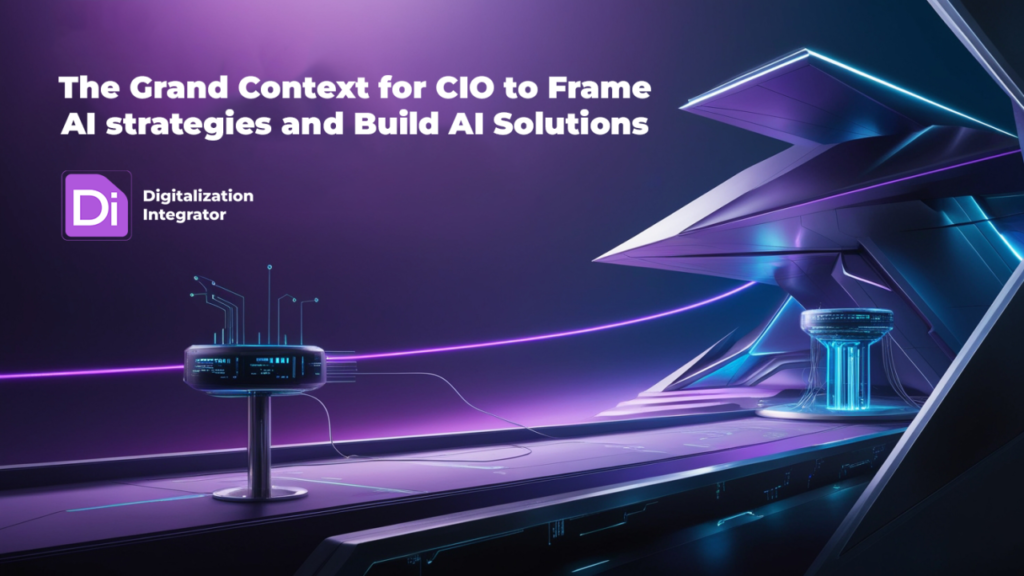The Grand Context for CIO to Frame AI strategies and Build AI Solutions
In today’s rapidly evolving technological landscape, Chief Information Officers (CIOs) must ensure that their organization’s AI solutions are developed within a strategic context. Simply implementing AI technologies based on knowledge standards is no longer enough. CIOs must think beyond the immediate benefits of AI and consider broader, long-term implications. This article outlines key principles for CIOs to consider when implementing AI solutions.
Choosing the Right Technology Stack
One of the most critical decisions CIOs face when adopting AI is selecting the appropriate technology stack. Broadly, there are three major technology stacks to consider: the US, Chinese, and European Union (EU) stacks.
This decision is increasingly influenced by geopolitical factors. The US technology stack is the most common, supported by leading companies such as Google, Microsoft, and Amazon, and is backed by a well-established infrastructure. However, with the shifting political climate, particularly the upcoming Donald Trump’s presidency, many countries will face pressure to choose between the US technology stacks and alternatives from China or the EU. The Chinese stack, while advanced, is closely intertwined with government policies and national interests, and intense US opposition it unviable for many countries. Meanwhile, the EU stack, lags behind in terms of independent AI chips, computational power and innovation speed but offers a more regulation-conscious option.
Depending on the geopolitical context CIOs may adopt a hybrid model allowing organizations to carefully navigate uncertain technological landscapes. Additionally, the hybrid model encourages experimentation with different technology ecosystems while mitigating risks tied to over-reliance on one technology stack.
Tread a Clear AI Pathway
It is crucial for CIOs to tread a clear pathway for AI adoption within their organization. This pathway consists of three options:
1. AI working for humans: Where AI serves humans, enhancing decision-making and automating repetitive tasks. This option enables humans to focus on what they are good at like relationships and leave AI for complex calculations and repetitive tasks.
2. AI integrated with humans: Where AI and human capabilities are intertwined, creating a seamless collaboration that enhances efficiency and creativity. However, this option also raises post-humanism implications, as the boundary between human and machine begins to blur. In this pathway, AI may not only assist humans but could potentially redefine what it means to be human, altering cognitive, emotional, and even ethical frameworks. This shift could provoke debates around identity, autonomy, and the role of human agency in a world where AI plays an integral part in personal and professional lives.
3. AI overload: In this option AI dominates decision-making process and marginalizes human involvement potentially resulting in a disconnect between the technology and organizational objectives.
CIOs must be strategic about where their companies are on this pathway and how they want to evolve, ensuring that AI adoption aligns with the company’s overall objectives and values.
Establish an AI Quartet Policy
The AI Quartet—comprising algorithms, data, chips, and energy—is a vital area for CIOs to address. Deciding between open-source or closed algorithms will shape how AI models are developed, implemented, and scaled. For example, open-source models may offer flexibility but pose risks in terms of security and control.
Equally, data and energy usage must be considered. The efficiency of AI models depends on high-quality, accessible data and sufficient energy resources. With AI models requiring substantial computational power, CIOs must plan for the energy needs and escalating costs that will scale with AI implementation.
Decide on the Target Operating Model
Another critical decision for CIOs is choosing the target operating model for AI integration. The options range from traditional legacy systems to fully autonomous AI-driven models.
1. Legacy model with some AI: AI is added to existing systems, which can create incremental improvements but may limit the full potential of AI.
2. Digital operating model with AI: AI is integrated more deeply into operations, enhancing processes and decision-making.
3. AI-controlled operating model: In this model, AI works within fixed workflows, automating tasks and decisions according to predefined guidelines. AI operates within this framework to ensure consistency and efficiency, streamlining operations and reducing human intervention in routine tasks.
4. Fully autonomous operating model: AI agents independently select tools and take actions to achieve outcomes without human intervention.
Choosing the right operating model depends on the level of trust the organization places in AI and the risk tolerance for autonomy.
Human-Centric Design
While technology plays a central role in AI adoption, it’s essential not to lose sight of the human aspect. Human-centric design must be at the heart of any AI strategy. However, finding the right balance can be tricky. Too much human involvement may result in AI systems that are deceptively human creating trust barriers with real humans, whereas too little can make the technology difficult to adopt or lead to misguided outcomes.
CIOs must design AI systems that are intuitive, enhance user experience, and are transparent in their functionality. This encourages adoption and ensures AI is working for people, not the other way around.
The Grand Context for CIO to Frame AI strategies and Build AI Solutions Read More »

